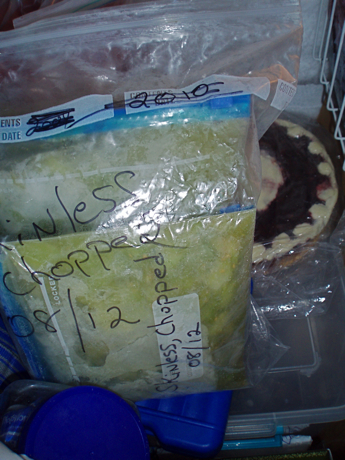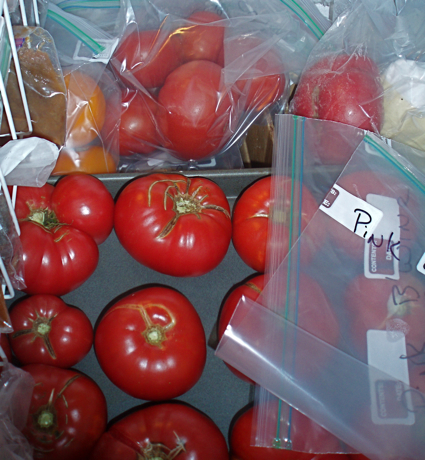Preserving the Tomato Harvest
It may seem a bit early to go all harvesty on you, but the first big flush of Hudson Valley tomatoes is usually the best for both quantity and quality, so that’s the one it makes sense to put up. The season of need will be upon us sooner or later (probably later, the way the weather’s been going lately), no matter how hard that is to imagine when it’s 72 degrees at dawn.
Equally unimaginable: canning – or at least extensive canning. I make an exception for Intensely Delicious Roast Tomatoes, but the bulk of our haul is a big reason I love the freezer.
To Freeze Whole Tomatoes
Choose unblemished fruit, size doesn’t matter and they don’t have to be uniform.
Rinse and dry them – or just wipe them off with a damp cloth if you know where they came from and they’re already pretty much clean.
Put them on a rimmed baking sheet in a single layer. Put the sheet in the freezer. That’s basically it.
Freezing takes anywhere from a couple of hours to overnight, depending on the size of the tomatoes and temperature of your freezer. As soon as they’re rock solid, transfer them to freezer bags. They will remain separate and can be removed individually. Very handy; sometimes you just want one.
Using Frozen Tomatoes
Think of them as puree-in-a-skin, a primo ingredient for soups, sauces and stews, but not usable in salads or sandwiches; freezing busts all the cells and the fruit collapses when thawed. (Some people put partially thawed cherry tomatoes in salads. Some people will do almost anything to prove a point.)
I always start by peeling them: dip the frozen tomato in hot water for about 10 seconds; the skin will split and slip right off. Cold water works too, it’s just less comfortable.
Then I put the tomatoes in a shallow bowl and let them thaw to sherbet texture. At this stage they’re easy to core, which I do. They get chopped at this stage too, if I’m in a hurry to get them thawed. Otherwise they can simply sit there (or be added as is to whatever you’d be pouring regular canned tomatoes into if you were reduced to using regular canned tomatoes).
Effortless Fresh Tomato Sauce
is in the archives somewhere, but writing it out again is faster than finding it.*
Peel some frozen tomatoes. Put them in a colander over a bowl that will catch juices. Let them sit until sherbet texture, core, then let them sit some more. They’re ready when completely thawed and thoroughly drained and should be used in the next couple of hours.
Transfer room temperature puree to a bowl, add a pinch of salt and taste. Quite a bit of flavor and most of the acid is in the drained-off juice, so it may be necessary to add lemon juice and/or sugar.
When you’re happy with the tomatoness of the puree, apply it to some pasta, along with a bit of fat. Olive oil is obvious, butter perhaps less so but delicious.
The drained off liquid is very tasty as a chilled drink (with or without some nice vodka like Cold River Classic). It can also be used as a soup base, for poaching fish or…just google “tomato water” and have a good time.

Hyper-ripe tomatoes with splits and bad spots can’t be frozen whole but are too flavorful to waste. Bill just throws the good parts in the blender and freezes the result; I peel and freeze in chunks (on account of not caring for the – admittedly very faint – bitter taste of ground seeds).
* When I mentioned the bumper crop to my good friend Nancy Jenkins, she was quick to recommend this method of making tomato sauce, which she thought she might have learned from our good friend Barbara Damrosch. Unless it was somebody else.
My guess is that this non-recipe recipe is as universal as frozen tomatoes. If you just put them in a bowl and leave them alone, the tomato water rises to the top and the flesh sits conveniently in the bottom, so leaping to the obvious conclusion is not exactly rocket science. (True of a lot of good cooking, in my humble.)

















My problem with this approach is full freezers. And we have three fridge freezers, and a stand up freezer. It’s why I bought a Pressure Canner – not just veggies, but soups and stock get done that way. Not the perfect solution, but it works.
Hi Scotty,
Sorry to hear about the full freezers; sounds as though you need a big chest model (as it were).
I need a walk-in!
WOW – that’s a serious haul of tomatoes! I never heard of freezing whole tomatoes – makes sense. Our “crop” here on the NH seacoast is pretty pitiful; what we do get generally goes directly to a caprese salad !
Hi Deb,
Can’t go wrong with caprese salad, but of course I’m sorry to hear your “crop” isn’t too cropish. That being the case, don’t forget end of season sales at farmstands/farmers markets. The pros usually manage somehow and when THEY have a glut they have to sell it fast and cheap.
Finding this post solves a problem for me. Thanks!